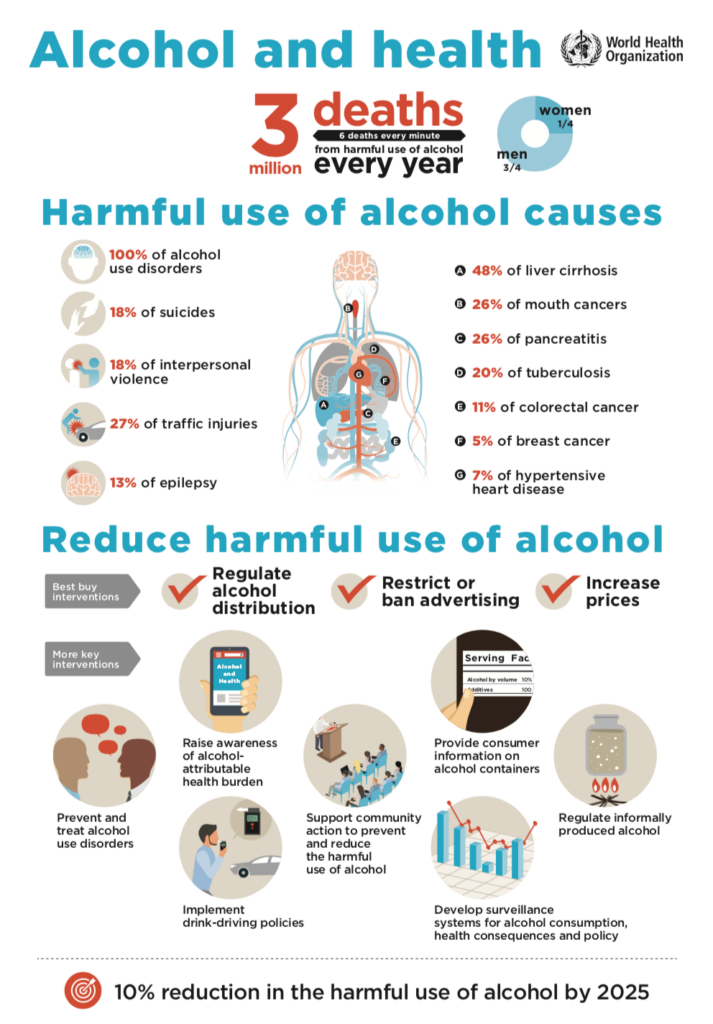
To adequately address a problem, it helps to have all the facts. Simply put, the United States and much of the western world has a harmful relationship with alcohol. Both young and older individuals alike are significantly impacted by alcohol-related harm, disease, and premature death. Right now, millions of Americans and hundreds of millions more around the globe are struggling with an alcohol use disorder (AUD). What’s more, the vast majority of people with AUD have never received any form of intervention or treatment.
A good many people maintain misconceptions about the impact of moderate and heavy alcohol use. It is easy to think that physical harm resulting from drinking occurs only after decades of consumption. However, wine, liquor, and beer have the power to kill in a relatively short time. Case in point: research appearing in the British Medical Journal (BMJ) indicates that the number of 25- to 34-year-olds who died annually from alcohol-related liver disease nearly tripled between 1999 and 2016 in the United States. Not surprisingly, men succumb at a far higher rate; men had a higher burden of age-adjusted mortality due to cirrhosis compared with women by a 2:1. Males lost their lives to hepatocellular carcinoma compared to women by a nearly 4:1 ratio.
The above figures from the BMJ highlight just how dangerous heavy alcohol use and AUD are in this country. Nearly a thousand Americans between the age of 25 and 34 died prematurely due to liver diseases in 2016. It seems impossible to ignore such figures and the life cost to society. Alcohol, alcohol use disorder, and dependence is a worldwide crisis, even though evidence-based treatments exist. A sharp look at the analysis of available research conducted by the World Health Organization (WHO) should give us all pause.
Global Status Report on Alcohol and Health
WHO reports that an estimated 283 million people aged 15+ years had an alcohol use disorder around the globe in 2016. While AUD can affect both sexes, the majority of individuals living with the condition are men. WHO found that 237.0 million adult men and 46.0 million adult women had an AUD in 2016. At the same time, hazardous alcohol use led to 3 million deaths (5.3% of all deaths) worldwide and 132.6 million disability-adjusted life years.
At PACE Recovery Center, our specialty is the treatment of males presenting for addiction and co-occurring mental health disorders. When we look at the WHO report, it is evident that alcohol use among men and women varies widely and, as such, the costs affect men more significantly. Alcohol-attributable deaths among men make up 7.7 percent of all global deaths compared to 2.6 percent among women.
For those living with alcohol use disorder, the presence of an AUD at least doubles the risk of having depression (WHO cites: Boden & Fergusson, 2011). Risk of suicidal ideation, suicidal attempts and completed suicide are each increased by 2–3 times among those with AUD (Darvishi et al., 2015). Alcohol consumption leads to major depressive disorders, according to two reviews (Boden & Fergusson, 2011; Fergusson, Boden & Horwood, 2009).
The relationship between alcohol and the onset of major depressive disorders is due, in part, to:
- Alcohol consumption leading to depression, and
- persons with depressive disorders being more likely to consume alcohol in larger volumes and in more detrimental patterns – i.e. the “self-medication” hypothesis (Bolton, Robinson & Sareen, 2009),
- the possibility of underlying genetic vulnerabilities that affect both the risk of depression and alcohol consumption.
Moving Forward
Three million people is a shocking figure, but it is probable that the total cost of life owing to alcohol use is even higher. The research on AUD and the prevalence of co-occurring mental illness like depression is a facet of the report that should guide future efforts to address mental health around the world. It is also worth noting that globally, more than 300 million people are living with depression; such men and women are at high risk of self-medication and developing an AUD as a result. The Global Status Report on Alcohol and Health is nearly 500 pages long, and anyone who would like more detail than we provide here is welcome to click this link.
The World Health Organization concludes:
With 3 million alcohol-attributable deaths in 2016 and well-documented adverse impacts on the health and well-being of individuals and populations, it is a public health imperative to strengthen and sustain efforts to reduce the harmful use of alcohol worldwide. A significant body of evidence has accumulated on the effectiveness of alcohol policy options, but often the most cost-effective policy measures and interventions are not implemented or enforced, and the alcohol-attributable disease burden continues to be extraordinarily large. The wealth of data and analyses presented in this report can hopefully provide new grounds for advocacy, raising awareness, reinforcing political commitments and promoting global action to reduce the harmful use of alcohol.
Alcohol Use Disorder Recovery
If you or a family member is one of the 237.0 million adult men living with AUD, please know that evidence-based treatments exist. With the help of PACE’s specialized clinical therapy for men addiction recovery is possible. We equip men with the tools to go from early recovery to long-term sobriety. Please contact us today to learn more about our program.
If you are in crisis, please call the National Suicide Prevention Lifeline at 1-800-273-TALK (8255) or contact the Crisis Text Line by texting TALK to 741741.



